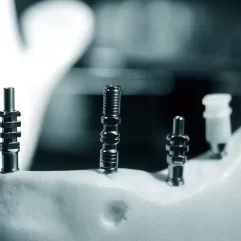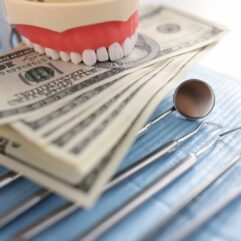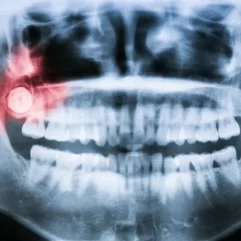Revitalize Your Smile Permanently with Implant Restorations
Implant Restorations: All-on-4s and Implant-Supported Bridges
Implant restorations have become a popular and effective solution for replacing missing teeth and restoring oral function and aesthetics. This advanced dental technology involves the use of dental implants to support customized prosthetic teeth, crowns, bridges, or dentures. Implant restorations offer numerous benefits, including improved chewing ability, enhanced speech, and a natural-looking smile.
In this blog post, we will explore the process of implant restorations, the types of implant restorations available, and the advantages they provide for patients seeking a long-term solution to tooth loss. Whether you are missing one or multiple teeth, implant restorations offer a durable and reliable option to restore your smile and confidence.
Are you considering rejuvenating your smile with a replacement or upgrading your old dentures with an implant restoration procedure? Perhaps you need multiple tooth extractions that make it feel like you’re back at square one with your dental health. Here’s the good news: All-on-4s, implant-supported permanent bridges, and snap-on dentures are promising solutions for implant restorations. By understanding the specifics of these treatments, you can choose the one that best suits your needs. This page provides a more in-depth exploration of these procedures while ensuring the information is digestible and easy to understand.
Implant restorations are far superior to permanent tooth replacement compared to traditional dentures, partials, and bridges (using natural teeth as anchors). They mimic natural teeth and support longer, multi-tooth restorations like All-on-4 and implant bridges. Understanding different options will help you feel more prepared before your implant consultation.
The all-on-4 dental implants reduce the wrinkles that come with missing teeth and actively support jawbone preservation. They are instrumental in retaining your inherent facial structure, which could otherwise decay due to tooth loss. Significantly, they enhance the aesthetic appeal of your teeth.
What is an Implant-Supported Bridge?
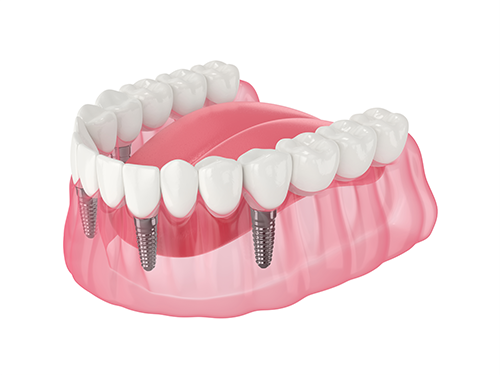
Side view of an all-on-4 hybrid denture components.
Implant restorations for bridges are almost like traditional dental bridges, except it’s supported by implants instead of your natural teeth. This option allows replacing more than two missing teeth in a row since conventional bridges should only fill in one or two teeth at most.
With implant bridges, they use one implant at each end of the restoration, placing them on either side of the open area in your bite. So, it’s replacing all teeth between your implants and those where they are placed. Usually, implant bridges fill in anywhere from three to four teeth in a row.
Occasionally, they might even recommend using additional dental implants for the same prosthesis if we need it to be longer. Unlike All-on-4s or Snap-in dentures, an implant-supported bridge has no pink gum prosthetic.
What is an All-on-4 Permanent Denture?
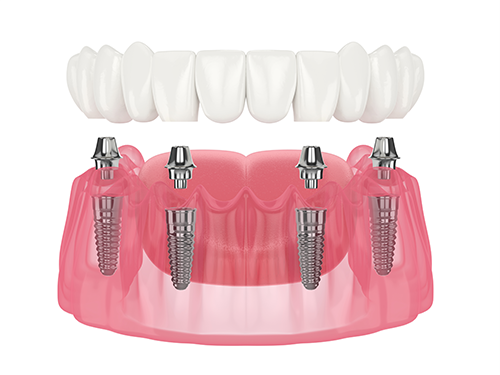
Front view of an all-on-4 hybrid denture components.
You could think of All-on-4s and All-on-6s as full-arch dental bridge implant restorations. Technically, it’s not a bridge because it’s filling in the space of both your teeth and the gum tissue immediately adjacent to them. But unlike a denture, it follows the natural U-shaped curve of your jaw. All-on-4 implants are like a hybrid between implant-supported fixed bridges and a complete denture, replacing all teeth in your upper or lower jaw with one prosthesis.
As the name suggests, full arch implant restorations are attached to four or six dental implants. While this might not seem like enough implants for an entire upper or lower set of teeth, it’s important to remember that implants are more robust than natural teeth. That’s why they can support the weight of a complete arch prosthesis, as long as they’re positioned at particular points in your jaw.
What is a Full Arch Hybrid Bridge with Single Crowns?
A “full arch hybrid bridge” is one of the best implant restorations available. It is an All-on-4 permanent denture with separate crowns for each tooth. It’s also called an “All-on-4 with individual crowns”. This procedure allows each artificial tooth to be individually customized and attached to the implanted framework, providing a more natural look and feel. However, the terminology can vary depending on the dentist or dental practice. One benefit of this option is that if a crown breaks, you only need to replace the broken one, and you can have it done at any dental office. The teeth are separated so they feel more natural. The prosthesis is lighter and more robust.
Is There Such a Thing as a Full Arch Implant Bridge?
When most people ask about a full arch implant bridge, they usually talk about All-on-4 or All-on-6 implant restorations. Bridges technically only restore the “crown” or visible tooth portion of your smile. You would want one when there’s plenty of healthy gum tissue there. However, extensive tooth loss usually triggers changes in the shape of your jaw and gums.
So, with an All-on-4 or All-on-6 procedure, they take your full arch bridge and build out the gummy “ridge” that usually hugs the necks of your natural teeth. Essentially, they’re rebuilding both the tooth and the gums around it, so your prosthesis has white and pink areas, filling in more than just tooth anatomy. This structural change is the critical difference between bridges and other tooth replacements.
When to Choose Implant Bridges Over Individual Implants
For example, if you’re not missing all of your teeth, maybe you have a few here and there that are perfectly healthy and stable for several more years of use. They don’t want to extract them to install a long, full-arch prosthesis when that’s the case. In those scenarios, the best solution for implant restorations is to place individual implants between the teeth or implant-supported bridge.
Typically, our doctors don’t need to replace multiple teeth in a row with single implants. Since implants are strong enough to support more weight than an anatomical tooth, using a pair of implants for an implant-supported fixed bridge is less invasive. For example, getting two implants with a three-unit dental bridge would probably be best if you have three missing teeth. But if you only have two teeth missing, you can go with an individual implant and crown for each tooth.
When to Choose All-on-4 or All-on-6 Permanent Dentures
Once our doctors are to the point of restoring an entire upper or lower set of teeth, only four to six dental implants are needed per arch. When you omit wisdom teeth (third molars), that’s 14 teeth per arch. Depending on your bone anatomy and how much support there is, they would choose specific points in your jaw to install your dental implants using an implant-guided placement technology to place dental implants in patients with missing or recently extracted teeth. Leveraging computer technology, the doctor can scan the patient’s oral cavity to form a 3D model. This allows them to strategize the most effective implant restorations before its execution.
Four to six implants are usually best for people with a bit more bone loss. That’s a little less than a 1:2 ratio of dental implants to missing teeth. Each implant supports the weight of just over two teeth, which is highly safe and predictable.
Which Option Is Right for Me?

Embarking on a journey to a confident smile: A patient seeks expert advice from a doctor for a transformative dental experience.
Anyone who has experienced tooth loss knows how embarrassing and debilitating it can feel not to have a healthy, functional smile. Usually, our implant specialists want to do everything they can to help you maintain your natural teeth and replace the missing ones around them. But if that’s not in the best interest of your overall health, therapeutic tooth removal is also an option.
When visiting our dental clinics, the doctor will review their findings and discuss your goals. Their approach is conservative, and they will only recommend the same type of treatment that we would want for ourselves or our family members.
Dental Implants in Mexico
Our dental clinics offer various tooth replacement options with implant restorations, including All-on-4 implants, implant-supported bridges, and snap-on dentures custom-designed to your natural facial anatomy. Those are just a few examples of options you have to choose from. No matter how many teeth you have missing or your smile goals, dental implants are one of the best options for restoring your oral health and smile.
MD.com is a good resource for additional information on oral health and dental implants.
If you have questions or need additional information, please Contact Us or Request a Quote to send us your dental inquiry, and we’ll get back to you.



